Hs-123 Page 2
Army Support on the
Eastern Front, 1941-1945
As in the blitz campaigns of 1939-40,
the dive bombers and fighters again played a major role in the victories
of the summer of 1941. The losses were relatively small, since the crews
were well-trained and confident on their planes' performance. Old
veterans went into air battles against Russian fighters without
hesitation in their Hs-123 or Ju 87 planes. Only the 4., 5. and 6.
Staffels of LG 2, equipped with Bf 109E-7s, suffered heavy losses. On
account of repeated motor and landing gear damage, there were seldom more
than three planes per unit ready for action, whereas 10. Staffel,
equipped with Hs-123s, had at least nine planes ready.
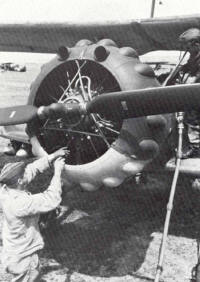 (Ref. a, pag.95)
(Ref. a, pag.95)
The two MG 17 guns installed over the
motor of the HS-123 could only be used against troops.
 (Ref. a, pag.97)
(Ref. a, pag.97)
The calm mood of this picture is
deceiving. In 1941 the Hs-123 flew more missions per plane than any other
model of airplane.
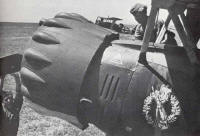 (Ref. a, pag.97)
(Ref. a, pag.97)
The motor cowlings, painted yellow
during the Balkan campaign, were green on top again in 1941.
 (Ref. a, pag.100)
(Ref. a, pag.100)
Hs-123 in winter paint, which could be
washed off.
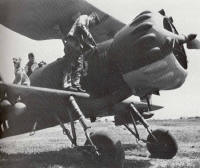 (Ref. a, pag.103)
(Ref. a, pag.103)
Overhauled and newly painted, the
Hs-123s of Sch.G 1 are ready for the summer offensive on the southern
front.
 (Ref. a, pag.103)
(Ref. a, pag.103)
This Hs-123 still has an annular sight
in front of the front window.
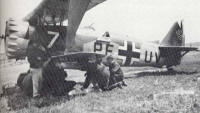
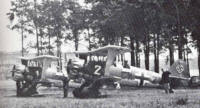 (Ref. a, pag.117)
(Ref. a, pag.117)
Training near the front with the
replenishment echelon of Sch.G 1 at Novocherkassk in 1942. The Hs-123s
bear the prewar regimental scheme.
References:
a) "Stuka" by
Gebhard Aders, Werner Held, 1989 Shiffer Publishing. ISBN:
0-88740-216-X
b) "Wing Masters"
Magazine, Nº 17 July-August 2000
c) "Luftwaffe
1935-1945 Pt.1" - Camouflages & Markings 1 (Eng. Text) by Jaroslaw
Wróbel, 1994 AJ-Press. ISBN: 83-86208-08-2
d) "Luftwaffe
1935-1945 Pt.3" - Camouflages & Markings 3 (Eng. Text) by Robert
Michulec, 1996 AJ-Press. ISBN: 83-86208-49-X
On to Page 3
 (Ref. a, pag.95)
(Ref. a, pag.95)